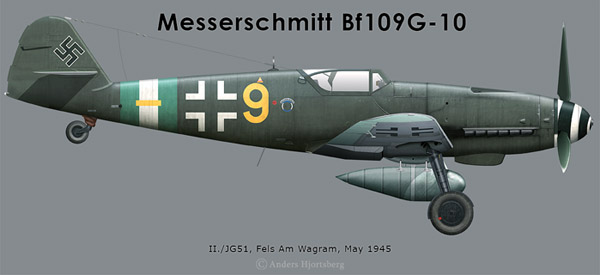Recently found photos from Fels Am Wagram in May 1945 shows a number of Bf109G-10's carrying fuselage bands with a white centre flanked by bands in a medium colour. These aircraft also carried the horizontal band of a II Gruppe unit applied on top of the fuselage bands. These markings are close in style to those of Jagdgruppe 300, but aircraft of that unit seems to have carried a small black horizontal band regardless of staffel colour.
As II./JG51 was disbanded at Fels am Wagram in april, these aircraft may well be the first known examples of the use of the green - white - green fuselage band assigned to JG 51.
An Erla built Bf109G-10 with the shorter tail wheel is also rare. The short wheel seems to have been used on some aircraft late in the production though. A notable example being the only known photographed Erla built Bf109K-4.

Nice to see another one of your great profiles. I'm curious about the stencils on the fuselage. It appears that some were painted with white / light colored background?
ReplyDeleteAlso, with Revell apparently releasing a new 1/32nd FW-190 series, any interest in some late war FW-190F-8's?
Regards,
John
Thanks!
ReplyDeleteThose stencils are actually decals printed on a light grey backing. I'm not sure about when Erla started using decals but they can be found on G-6's. They stand out a lot more on these dark coloured G-10's though.
Så, typ Rlm 81 på kroppen men var vingarna också enfärgade?
ReplyDeleteFörmodligen enfärgade vingar. På de få maskiner från Erla med det här mörka kamouflaget där vingarna är tydligt fotograferade, verkar färgerna stämma överens på kroppen och vingarna.
ReplyDeleteIntressant! Ska bli enfärgad modell så småningom, i 1/48 eller 32.
ReplyDeleteTack!
Anders, do we know if those were Cartograf decals? :-)
ReplyDeleteThis is a neat find, definitely a step away from the ordinary!
Best regards,
Lynn
Hi Anders, beautiful profile, the all-green Erlas have a special charm to them, don't they.
ReplyDeleteBut I was wondering, if it is indeed the case that the 109's with a light fuselage-band, with a white centre and a short black horizontal line, were in fact from JGr 300, then isn't it more likely the ones from Fels am Wagram were also JGr 300, only that for some reason their horizontal line was done in yellow? I mean the style of the fuselage band is all but identical, e.i. the horizontal line is done in one solid colour (no outline), is set in the middle of the band, and only barely goes over the darker colour, perhaps by a few cm. on each side. As far as I can see JGr 300 also largely consisted of Erla builds, some of them of the late all-green variety, just like in the photos from Fels am Wagram. Or am I missing something more, does their location perhaps preclude them form being JGr 300?
Everything is possible when it comes to Luftwaffe and this late part of the war. A few things that I've noted though is that the markings style of the aircraft at Fels am Wagram is slightly different, the gruppe bar is placed slightly lower than what is usual with JGr 300 aircraft and as noted, the wrong colour.
ReplyDeleteAccording to documents, JGr 300 was being formed at Ainring on May the 3rd 1945 just as the unit was ordered to transfer to Prague. Meanwhile, Fels am Wagram was captured by the Russians on May the 4th so it seems unlikely that JGr 300 flew there in that short timespan.
That's always assuming that the documents are correct. The black bands could have been added earlier and JGr 300 could perhaps been formed earlier as well.
Also, it's not 100% established, although likely, that the aircraft with JG300 fuselagebands and black gruppe bar actually was from JGr 300.
Forgot to add that even days before Fels am Wagram was actually captured, it must have been known that the Russians were closing in and that would have discouraged pilots to fly there.
ReplyDeleteThank you Anders. Yes, I suppose it would be strange at a time when the Luftwaffe was trying to get as far from the Russians as possible, for one Gruppe to be travelling in the opposite direction. In fact I seem to remember an account by a JGr 300 pilot about how days before the war's end, the Gruppe-komandor put on a mechanics overalls and disappeared with a Bü-181, supposedly to surrender to the Americans.
ReplyDeleteThis was probably just a stupid assumption by me, since it seems that these photos are labelled as JG 51 in most places (e.g. FalkeEins). But in my defence, the Gruppe-bars almost seem to have been done by the same hand.
Anyways, I guess i'll have to edit some of my Il-2 skins now, which incidentally leads me to an important question - do you think you'll be taking up Il-2 skinning at all again? Your Bf-109 skins especially really are the gold-standard in my eyes.
Oh, and one other comment, in one of the photos from Fels am Wagram of an all-green G-10, the underside of the tailplane almost certainly seems to be done in dark green too, though the underside of the elevators are light blue. Doesn't it seem likely that this applied to all the all-green Erlas, seeing as the all-green was a time and labour saving effort?
ReplyDelete